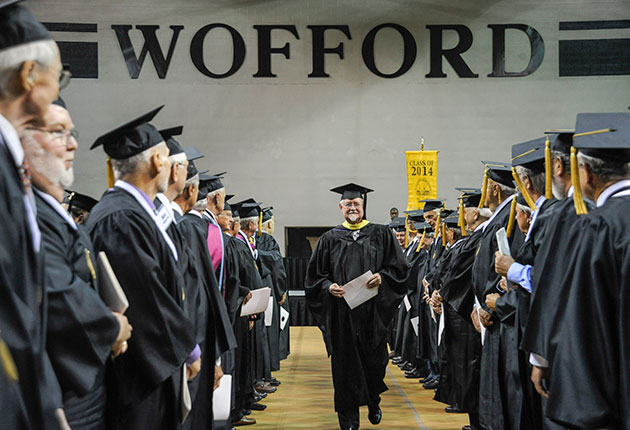The typical undergraduate library in the early 1980s had a language and a process that today’s students would barely recognize: a cabinet that contained the card catalogue; shelves straining with bound copies of old academic journals; and some distinctive features such as Wofford’s antique printing press skillfully operated by the late Frank J. Anderson.
In 1984, Oakley H. Coburn was chosen from the Wofford staff to steer the library into the future. He retired at Commencement this spring as dean of the library emeritus, having shaped the Sandor Teszler Library into an attractive and functional 21st century resource. A master planning effort is now underway that will define specific goals and needed resources for the future.
“Wofford always has had a good library — there’s no question about that,” says Coburn. “The late Frank Anderson, his staff of professional librarians, and the faculty had supported and developed it in a way that was consistent with what was expected at Phi Beta Kappa liberal arts colleges. Early in the 1970s we acquired a beautiful building named for the late Sandor Teszler.
“But by the 1980s, we knew that times were changing very quickly indeed. We required a careful investment in all kinds of new technologies as well as collaboration with other institutions, both academic and otherwise. That’s still true in 2014.”
Coburn began his tenure by traveling extensively to look at how other college libraries were moving forward. It was easy to see that South Carolina had a large number of small academic libraries with similar collections, and he became a recognized leader in the process of networking.
Gradually, over a period of years, professional librarians across the state found that they could work together. The product of their relationships is called PASCAL. It stands today as a flexible model for other states for having saved taxpayers thousands of dollars. It offers many advantages over a centralized, top-down interlibrary structure.
In order to accomplish these goals, Coburn recruited the best professionals he could find and made it clear that they would have the authority to do their jobs.
In 2000, Dr. Joe Lesesne retired as the Wofford president and was replaced by Dr. Benjamin Dunlap. Dunlap asked Coburn to accept a newly created position as one of the deans of the college. In addition to the work Coburn continued to do in the library, he joined the president’s cabinet and accepted the challenge of coordinating arts programs for the college as part of an emerging arts and cultural program at the Chapman Cultural Center.
“We had had good programming in theatre and choral music (but no majors) for many years,” Coburn says. “This success convinced us that there was enough student and faculty interest in the arts for Wofford to become better.”
“Ironically, the first concrete opportunity to experiment came when staff discovered a fine early 20th century portrait of John B. Cleveland tucked away in a storage room. It was in grave danger of permanent deterioration. Members of the Cleveland family stepped forward with donations, and soon we had an award-winning series of portraits that are making an important contribution to South Carolina history,” he says, “pointing out that many of these pieces hang in the board room of the DuPre administration building.”
An important footnote to the story involves Coburn’s many personal trips in carefully packed rental trucks to discuss projects with conservators at the North Carolina state museum in Raleigh.
More recently, Coburn has quietly led in the development of the Teszler-Robicsek Collection of Hungarian art, giving Wofford one of the finest examples of its specific genre in the United States. “We’ve also acquired some nice pieces of African art that correspond to a specialty of a member of our faculty,” he says.
Coburn says that after four decades of direct involvement in the academic field, he, his wife, Louisa, and son Nathaniel ’06 thought the time had come for Coburn to retire. He has been busy this summer developing a personal study and studio in his eastside Spartanburg home, and he’s looking forward to a full life in Upstate South Carolina.
In future years, Wofford alumni and friends should not be too surprised to open their mailboxes and find a card from Coburn complete with one of his whimsical illustrations and more creative ideas for promoting the arts and literature in Spartanburg.
By Doyle Boggs '70
Coburn Named Dean of Library Emeritus upon Retirement
